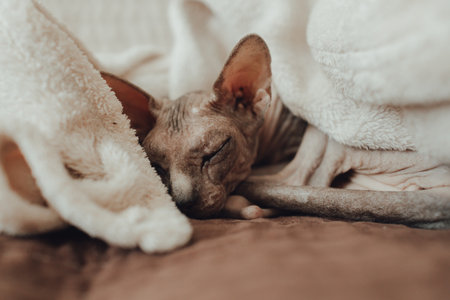Introduction to Cat Litter Waste in the UK
The United Kingdom is a nation of animal lovers, with cats being one of the most popular pets across British households. According to recent surveys, it is estimated that over 11 million cats are kept as pets in UK homes, making feline companions an integral part of family life. With this high prevalence of cat ownership comes the responsibility of managing cat litter waste in a manner that supports both household hygiene and environmental sustainability. Improper disposal of cat litter can lead to unpleasant odours, attract pests, and contribute to landfill issues, while also posing risks to local water systems and wildlife. Understanding the regulations and best practices surrounding cat litter waste is crucial for pet owners who want to maintain a clean home and minimise their ecological footprint. The following table provides an overview of cat ownership and common types of cat litter used in the UK:
| Aspect | Details |
|---|---|
| Estimated Cat Population | Over 11 million |
| Common Cat Litter Types | Clay-based, silica gel, biodegradable/plant-based |
| Main Concerns | Odour control, hygiene, environmental impact |
As awareness grows regarding the impact of pet waste on both human health and the environment, it becomes increasingly important for UK cat owners to familiarise themselves with current regulations and effective disposal methods. This ensures not only a cleaner living space but also contributes positively to broader public health and ecological outcomes.
UK Regulations on Cat Litter Disposal
Disposing of cat litter in the UK is subject to both national and local regulations designed to protect public health and the environment. The Department for Environment, Food & Rural Affairs (DEFRA) provides overarching guidance, while local councils and environmental agencies may set specific rules based on regional needs and waste management facilities.
National Guidance from DEFRA
DEFRA advises that used cat litter should not be flushed down the toilet, as it can cause blockages in the sewage system and potentially contaminate water supplies. Instead, cat litter is generally considered household waste. The recommended approach is to place it in a securely tied bag before disposing of it in your general waste bin. This prevents odours and reduces the risk of environmental contamination.
Local Council Regulations
Local authorities across England, Scotland, Wales, and Northern Ireland may have slightly different rules regarding cat litter disposal. Some councils provide specific advice on their websites or leaflets distributed to residents. For instance, a few may accept biodegradable or compostable litters in garden waste collections, but most request that all cat litter—regardless of type—is placed in the residual (non-recyclable) waste bin. Residents are encouraged to check with their local council for any unique requirements or collection schedules.
Summary Table: Cat Litter Disposal Guidelines by Region
| Region | Main Guidance | Special Instructions |
|---|---|---|
| England | General waste bin | No flushing; bag securely |
| Scotland | General waste bin | Check for biodegradable options with council |
| Wales | General waste bin | Avoid recycling bins; confirm with council for compostable litter policies |
| Northern Ireland | General waste bin | No garden/food waste bins for cat litter |
Environmental Agency Recommendations
The Environment Agency stresses the importance of minimising the impact of pet waste on landfill sites and waterways. They advise never to dispose of cat litter in natural habitats or public spaces due to potential harm to wildlife and contamination risks. Additionally, households with vulnerable individuals should take extra care when handling soiled litter, as it may contain parasites like Toxoplasma gondii.
By adhering to these regulations and seeking updated information from your local authority, you can ensure responsible cat litter disposal that aligns with UK best practices and protects both human health and the environment.

3. Types of Cat Litter and Their Disposal Implications
Choosing the right type of cat litter is not just a matter of convenience or preference; it also has significant implications for waste disposal in accordance with UK regulations. Below, we outline the most common types of cat litter available in the UK and provide guidance on how each should be disposed of to protect public health and the environment.
Common Types of Cat Litter in the UK
| Type | Main Characteristics | Disposal Recommendations (UK) |
|---|---|---|
| Clumping Clay (Bentonite) | Forms solid clumps when wet, easy to scoop | Dispose of in general waste; not compostable or flushable |
| Non-Clumping Clay | Absorbs moisture but does not form clumps | General waste bin; avoid flushing or composting |
| Silica Gel Crystals | Highly absorbent, controls odour well | General waste only; not suitable for composting or flushing |
| Biodegradable (Wood, Paper, Corn, Wheat) | Made from natural materials, breaks down over time | Some local councils allow green bin disposal (check local guidelines); otherwise, general waste. Do not flush. |
| Recycled Paper Pellets | Made from recycled paper, gentle on paws | If soiled, place in general waste; small amounts may be accepted in garden waste in certain areas—verify with your council. |
Official Guidance on Cat Litter Disposal
The UK Government and local councils generally recommend disposing of used cat litter in your regular household waste bin. This is primarily due to the risk of toxoplasmosis and other pathogens that can pose a risk to human health and wildlife if cat faeces enter the compost stream or are flushed down toilets. While some biodegradable litters are marketed as compostable, most councils advise against adding any pet waste—including cat litter—to food or garden waste collections unless explicitly stated otherwise in local guidance.
Council Variations and Local Schemes
It is important to check with your local authority for specific instructions, as some regions may have pilot schemes or exceptions for certain biodegradable litters. However, as a rule of thumb:
- Never flush cat litter down the toilet or drains.
- Avoid composting soiled cat litter at home unless you have a dedicated pet waste composter not used for edible plants.
- If in doubt, use your general waste bin.
Sustainable Choices for Pet Owners
If environmental impact is a concern, opt for biodegradable litters made from renewable resources and packaged in recyclable materials. However, always prioritise public health by following safe disposal practices as outlined above.
4. Best Practices for Domestic Cat Litter Disposal
Proper disposal of cat litter in the UK is essential to maintain household hygiene, prevent environmental contamination, and comply with local waste management guidelines. Here are some practical tips and methods that UK pet owners can adopt to safely and hygienically dispose of used cat litter:
Choosing the Right Cat Litter
Selecting an appropriate cat litter can simplify disposal and minimise odours. Biodegradable options, such as wood pellets or recycled paper, are increasingly popular for their eco-friendly credentials. However, always check your local council’s guidance before composting any pet waste, as not all types are suitable.
Daily Maintenance and Hygiene Tips
| Action | Benefit |
|---|---|
| Remove soiled litter daily using a scoop | Reduces odour and bacterial build-up |
| Wear disposable gloves when handling waste | Protects against direct contact with pathogens |
| Clean litter trays weekly with hot, soapy water | Maintains hygiene and prevents lingering smells |
Bagging and Bin Disposal Methods
Used cat litter should be double-bagged in strong, leak-proof bags before being placed in the general waste bin (rubbish bin/black bin). Avoid flushing cat litter down toilets or drains as this can cause plumbing issues and pollute waterways. For those using biodegradable litters, check if your local authority allows green bin disposal—most councils do not accept animal waste in food or garden waste collections.
Tackling Odours Effectively
- Store bagged waste in a lidded outdoor wheelie bin until collection day.
- Add a small amount of bicarbonate of soda to the bottom of the litter tray to neutralise smells.
- Avoid placing used litter bags near windows or entryways to reduce unpleasant odours indoors.
Reducing Environmental Contamination Risk
Avoid mixing cat litter with recyclable or compostable materials unless explicitly permitted by your local council. Always follow local authority advice for waste sorting and disposal, which helps reduce the risk of contaminating recycling streams or spreading harmful pathogens.
5. Environmental Considerations and Sustainable Alternatives
The environmental impact of cat litter waste is a growing concern in the UK, as sustainability becomes increasingly important in everyday life. Different types of cat litter materials have varying effects on the environment, from production to disposal. Understanding these differences can help pet owners make informed choices that align with both regulatory guidelines and the UKs commitment to reducing landfill waste.
Comparing Cat Litter Materials: Environmental Impact
| Litter Type | Source Material | Biodegradability | Recyclability/Composting | Common Disposal Method (UK) |
|---|---|---|---|---|
| Clay-based (Bentonite) | Mining (non-renewable) | Non-biodegradable | No | General waste bin |
| Silica Gel | Synthetic (silicon dioxide) | Non-biodegradable | No | General waste bin |
| Wood/Paper-based | Sustainably sourced wood/paper | Biodegradable | Yes (some councils allow composting) | Check local guidance; often general waste bin |
| Corn/Wheat/Bamboo-based | Renewable plant materials | Biodegradable | Some can be composted (not for food crops) | Check local guidance; often general waste bin or compost heap (pet waste restrictions apply) |
Choosing Eco-Friendly Cat Litter Options
To support the UK’s sustainability goals, pet owners are encouraged to opt for biodegradable and renewable cat litter products where possible. Wood pellets, recycled paper, and plant-based litters are generally less harmful to the environment compared to clay or silica alternatives. However, it is crucial to note that even biodegradable litters should not be flushed down the toilet, as this can contribute to waterway pollution and disrupt wastewater treatment systems.
Sustainable Disposal Advice for UK Pet Owners
- Select products certified as sustainably sourced or made from recycled materials.
- If available, use local council-approved composting schemes for biodegradable litters—but always follow official guidance, particularly regarding pet waste composting restrictions.
- Avoid using plastic bags when disposing of litter; consider compostable liners or newspaper instead.
The Role of Responsible Consumer Choices
By examining product labels, supporting brands with strong sustainability practices, and staying updated on local authority recommendations, cat owners in the UK can significantly reduce their environmental footprint. Thoughtful selection and disposal of cat litter not only comply with regulations but also contribute to broader efforts in achieving a greener and cleaner Britain.
6. Professional and Community Resources
When it comes to responsible cat litter waste disposal in the UK, a range of professional and community resources are available to support pet owners. These resources not only provide guidance on regulatory compliance but also offer practical solutions for everyday waste management. Below is an overview of key organisations and how they can assist:
Veterinary Professionals
Vets are often the first point of contact for advice on pet health and related environmental responsibilities. Many veterinary practices offer information leaflets or consultations about safe cat litter choices and disposal methods, ensuring that waste does not pose risks to either public health or the environment. They may also recommend eco-friendly litter products or provide referrals to local recycling schemes.
Local Councils
Your local council plays a crucial role in waste collection and disposal regulations. Councils can inform you about:
| Resource | Description |
|---|---|
| Bin Collection Schedules | Details on which bins cat litter should go into (e.g., general waste) |
| Recycling Facilities | Information on centres that accept specific types of cat litter |
| Hazardous Waste Advice | Guidance for disposing of used litter from cats with infectious diseases |
Check your council’s website or contact their environmental services department for tailored advice.
Environmental Charities and Organisations
Several UK-based environmental charities promote sustainable pet care. Groups such as Keep Britain Tidy, Cats Protection, and The Wildlife Trusts offer educational resources, campaigns, and sometimes even workshops on reducing your household’s ecological footprint—including responsible pet waste management. Their websites often feature downloadable guides and tips on composting biodegradable litters or joining community initiatives to reduce landfill waste.
Useful Contacts at a Glance
| Organisation | Website/Contact Details |
|---|---|
| Cats Protection | www.cats.org.uk |
| Your Local Council | gov.uk/find-local-council |
| Keep Britain Tidy | www.keepbritaintidy.org |
Key Takeaway
Utilising these professional and community resources ensures that cat litter waste is disposed of responsibly, keeping both your pets and the wider UK environment safe and healthy.


